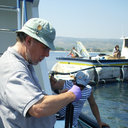Role of pulmonary edema in the acute pulmonary response to sepsis.
Sleutelwoorden
Abstract
There is evidence that both bronchoconstriction and accumulation of lung water may contribute to the early alterations in lung function following septicemia. Eigher of these may be mediated by blood components. To assess these proposed mechanisms the changes in hemodynamics, pulmonary mechanics, gas exchange, and gravimetric lung water were measured in the first 4 h after Escherichia coli infusion in the anesthetized dog and baboon. These species were selected because of previously demonstrated differences in the response to gram-negative sepsis. Both species developed systemic hypotension and early hypoxemia. The dogs had early transient increases in venous admixture (Qva/Qt) but not shunt or dead space, while the baboon had a more persistent increase in Qva/Qt and a late increase in dead space, Increases in nonelastic resistance and decreases in lung compliance were preceded or accompanied by decreases in the leukocyte count in both species, but the platelet count, fibrinogen, and total hemolytic complement had different changes in the two species. Postmortem lung analysis revealed increased lung weight in both species but the wet weight-to-dry weight ratio was not increased in either species. The fractional water content of the excess lung mass was less than that of whole blood. Histological examination revealed large numbers of extravasated leukocytes in the lungs, which may be sufficient to explain the increase in lung weight. We conclude that pulmonary edema does not play a role in the early pulmonary response to E. coli bacteremia in either species. The physiological changes observed are more consistent with bronchoconstriction.


